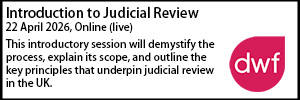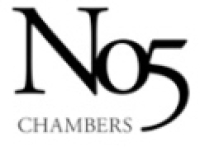- Details
Barrister-solicitor distinction could be more decorative than functional: Law Soc President
The Law Society President has said he envisages the time coming when the barrister/solicitor distinction will be “more a decorative than a functional aspect of our legal constitution”.
In a speech at the Said Business School in Oxford this week, John Wotton suggested that the changing nature of the legal market – including the advent of alternative business structures – would be a driving force for change.
Wotton said: “The new modes of practice will increasingly challenge the norms under which lawyers practise under the separate titles of barrister and solicitor.
“I believe this development will lead inevitably to the need to revisit the question whether these two professions should continue to be separately trained, represented and regulated, as they have been for the past 180 years.”
The Law Society President, a consultant at City giant Allen & Overy, insisted that he did not expect the professions to fuse. He said he assumed that the two separate professional titles of barrister and solicitor would survive for the foreseeable future, “if only because there is no strong current of opinion in favour of fusion on the part of members of the professions or their clients”.
Wotton added that the future might see the distinction between barrister and solicitor be “more a matter of tribal culture than function, rather like the distinction between a Cambridge and Oxford degree”.
However, he argued that education and training was likely to converge and that more advocates would start their careers in law firms rather than barristers’ chambers.
Wotton said: “There must be competitive advantages and efficiencies to be gained from having the full range of dispute resolution services under the same roof.”
He added that it was “entirely rational” for corporate law firms to recruit experienced barristers.
The Law Society President noted the Bar’s move to adapt its traditional, sole practitioner, chambers structure to compete more effectively for legal aid contracts and other work, which he suggested appeared to be a recognition of the imperatives of the current market.
“But will it make sense for somewhat artificial structures to be set up, such as a ‘ProcureCo’ established by a set of chambers to enter into legal aid contracts, procuring advocacy from the members of chambers and litigation from solicitors, when any mixed solicitor/barrister, SRA-regulated practice can provide an integrated service?” he asked.
“Given the multiplicity of providers in the market for most types of work, it seems unlikely that attempting to sidestep the conflict of interest issues that arise within a partnership, by retaining the vestiges of independent sole practice, will be sufficient to justify the additional costs of establishing such structures.”
Wotton also argued in his speech that the regulatory structure under the Legal Services Act would be capable of maintaining the independence and standards of the legal profession and operating successfully in the new environment.
However, he urged the Legal Services Board to recognise the limits of its statutory remit and the approved regulators acting independently of the LSB.
Solicitor - Litigation
Governance Lawyer
Antisocial Behaviour Legal Officer
Contracts Lawyer
Regulatory/Litigation Lawyer
Legal Adviser
Solicitor/Lawyer (Contracts and Procurement)
Legal Director - Government and Public Sector
Deputy Director Legal and Democratic Services
Lawyer (Planning and Regulatory)
Locum roles
 Masterclass – MCA and Court of Protection - Legal Update - Peter Edwards Law Training
Masterclass – MCA and Court of Protection - Legal Update - Peter Edwards Law Training
21-01-2026
Online (live)
 Managing settlements: the legal and practical issues, and the pitfalls to avoid - Blake Morgan
Managing settlements: the legal and practical issues, and the pitfalls to avoid - Blake Morgan
22-01-2026 10:00 am
Online (live)
 Children and Young People (DoL, Competency and Capacity) - Peter Edwards Law Training
Children and Young People (DoL, Competency and Capacity) - Peter Edwards Law Training
28-01-2026
Online (live)
 HMPL Building Blocks: Legal Tools to Combat Anti-Social Behaviour - Devonshires
HMPL Building Blocks: Legal Tools to Combat Anti-Social Behaviour - Devonshires
17-02-2026
Online (live)
 Freedom of thought, belief and religion: Article 9 ECHR - Francis Taylor Building
Freedom of thought, belief and religion: Article 9 ECHR - Francis Taylor Building
19-02-2026
Online (live)
 Grappling with S73 - variations of conditions applications or appeals - Ivy Legal
Grappling with S73 - variations of conditions applications or appeals - Ivy Legal
09-03-2026
Online (live)
 HMPL Building Blocks: Tenancy Management – Assignment, Mutual Exchange and Succession - Devonshires
HMPL Building Blocks: Tenancy Management – Assignment, Mutual Exchange and Succession - Devonshires
12-03-2026
Online (live)
 Section 31(2A) Senior Courts Act: where have we got to? - Francis Taylor Building
Section 31(2A) Senior Courts Act: where have we got to? - Francis Taylor Building
18-03-2026 1:00 pm
Online (live)
 Save the Date: The Law of Public Rights of Way, Commons and Town or Village Greens Seminar (Hybrid) - Francis Taylor Building
Save the Date: The Law of Public Rights of Way, Commons and Town or Village Greens Seminar (Hybrid) - Francis Taylor Building
25-03-2026
London
 HMPL Building Blocks: A Housing Officer’s Guide to Court Proceedings - Devonshires
HMPL Building Blocks: A Housing Officer’s Guide to Court Proceedings - Devonshires
14-04-2026
Online (live)




























































































































 First Aid Level 3 - LBL Skills
First Aid Level 3 - LBL Skills  Capsticks Housing Diploma
Capsticks Housing Diploma  Standish 18 months on - 42BR
Standish 18 months on - 42BR  Accelerating EV Charging Infrastructure in the Public Sector - DWF
Accelerating EV Charging Infrastructure in the Public Sector - DWF  Building Safety Act Conference 2026 - Landmark Chambers
Building Safety Act Conference 2026 - Landmark Chambers  Education Law Conference - 3PB
Education Law Conference - 3PB  Annual Planning Seminar 2026 - No.5 Barristers
Annual Planning Seminar 2026 - No.5 Barristers 